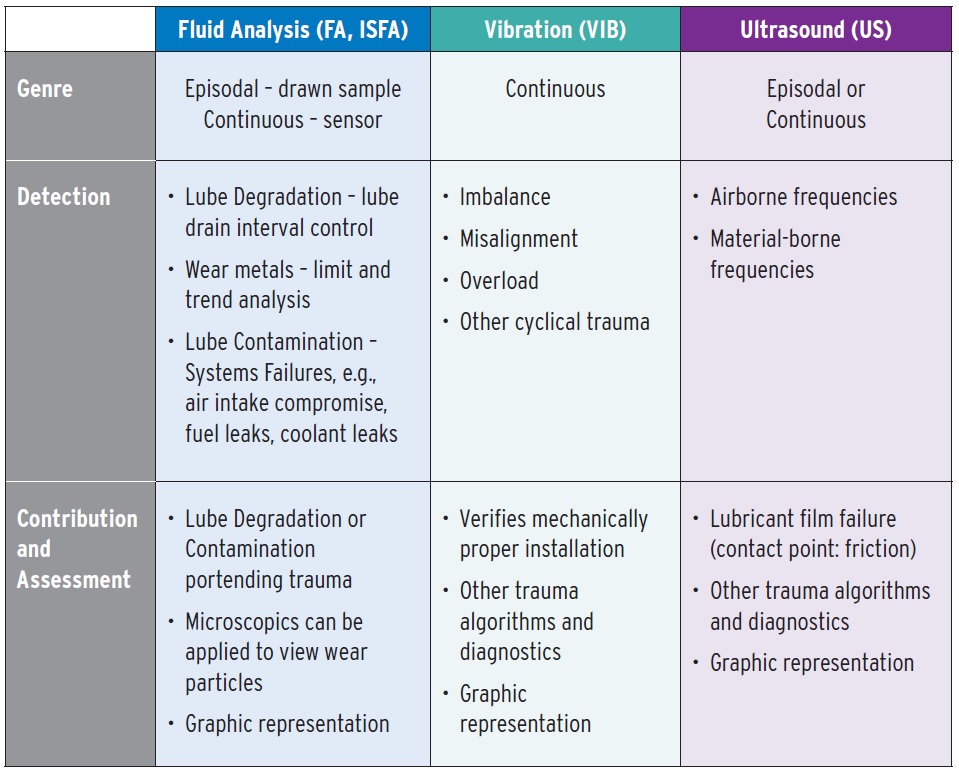Complexity in ISFA (in-service fluid analysis): Part XXXIV
Jack Poley | TLT On Condition Monitoring September 2017
Changing of the guard in machine condition monitoring?
IN-SERVICE FLUID ANALYSIS (ISFA) AND VIBRATION (VIB) are the two widespread, dominant techniques for non-destructive (NDT) machine condition monitoring (MCM). But ultrasound (US), adapted from medical industry instrumentation, has certainly inserted itself into the discussion of
de rigueur methodology for MCM. With no intent to blur the fact that ultrasound addresses more divergent conditions than does VIB, ultrasound is a parallel or subset, like VIB, of wave diagnostics, since frequency measurement and assessment is involved. Still, US provides additional insights as additive to the knowledge that can be gleaned when it is applied.
US (mid-1990s) arrived significantly later to MCM than ISFA (1948) and VIB (mid-1970s). Its original application was leak detection and dispensing control for lubrication management, particularly controlled grease recharging of bearings. In recent years it has taken hold in numbers of ways as an MCM tool, working its way into P-F curve models, at times even more sensitive as to detection of certain trauma types than ISFA or VIB. Nevertheless all three MCM tools can assume the lead position, dependent on a given machine’s lube or mechanical condition.
That US can expose additional trauma occurrence or potential, including stationary and non-rotating measurements, from VIB or assist ISFA, which serves to underscore the evolution of MCM since its inception in the late 1940s (ISFA, as introduced by the U.S. railroad industry). Bottom line: US is a coming player, likely to sit directly at the table routinely with ISFA and VIB in a few years in terms of popularity.
ISFA has evolved tremendously as well, most notably, in the viability and proliferation of mechanically sound sensors to partially remove ISFA from episodal confinement to real time, with the consequence that both ISFA and VIB will begin to find themselves frequent co-partners in real-time MCM. In fact, some static measurement benefits of US may actually
blend better with ISFA in terms of machine health diagnoses prior to VIB indications.
So now there are three strong players in routine MCM, and thus we’ve the proposition of belt, suspenders and perhaps
Velcro in holding up one’s pants (er, machine). Well and good; the objective of MCM is to preserve asset health by any or all means. It’s all good. More information, properly integrated, leads to better assessments and diagnostics.
Figure 1 contains characteristics of the current two pillars of MCM, along with US.
 Figure 1.
REALITY CHECKS
Figure 1.
REALITY CHECKS
While it would be nice if one could conclude that ISFA sensors would obviate the need for additional ISFA testing (Tier 2 Onsite or Tier 3 Offsite), that (presumed) goal, that may be accomplished in time, is yet a decade or two away (as I’ve been saying for a decade or two). Because ISFA sensors have not nearly covered the relatively wide range of lubricant testing that is required to have a comprehensive, meaningful ISFA test result set. Moreover, there are some sensor measurements that are not as sensitive as laboratory-based analyses, obviously providing more limited insight to machine and/or lube condition. Then, too, it is a matter of cost. ISFA sensors are still relatively expensive for certain specific measurements. As such they are mainly ensconced in military equipment, commercial aviation and marine and large stationary installations such as steam and gas turbines.
One important piece of good news is that newer lab instruments, at this time those primarily dealing with ferrous (iron-dominated) metals, can actually detect and quantify larger particle sizes (from 4-20µ up to several hundred microns, depending on the specific instrument) than traditional spectrometric instruments, as used in most labs* can, providing insight as to wear that is more likely to be traumatic. In these cases, being able to compare these types of inspections with traditional spectrometric lab results for Fe concentration can shed a lot of light as to wear conditions, in terms of urgency. VIB and/or US could very well act as arbiters between smallish Fe (<4µ) and “chunk” Fe.
The increasing demand for Tier 2 testing will significantly help bridge the information time gap (from Tier 3) until sensors can match up more thoroughly.
I noted last column that examples of VIB and ISFA corroboration were not common. In the coming months I hope to have the opportunity to gather and analyze both types of information, perhaps including some US data as well, in order to share some algorithmic examples that I’d expect to demonstrate holistic synergy and an additional path for MCM, where increasingly better asset management is possible.
*As instrument manufacturers continue to find ways to overcome barriers to detectability and repeatability in their wares, the industry is starting to produce instruments that detect more holistically, particularly those instruments addressing ferrous (Fe-based) particles, wherein challenges such as size and concentration are being overcome. Thus, we now have several instruments on the market that address TOTAL Fe. Most of these are using magnetometry, similar to the popular PQ instrument, although the PQ does not purport to determine TOTAL Fe, nor should it. PQ is well established for what it is, a great screening tool for Fe wear.
 Jack Poley is managing partner of Condition Monitoring International (CMI), Miami, consultants in fluid analysis. You can reach him at jpoley@conditionmonitoringintl.com
Jack Poley is managing partner of Condition Monitoring International (CMI), Miami, consultants in fluid analysis. You can reach him at jpoley@conditionmonitoringintl.com.
For more information about CMI, visit www.conditionmonitoringintl.com.